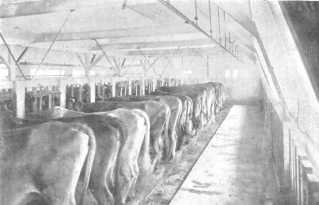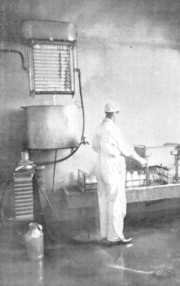Disclaimer
The Dover Public Library website offers public access to a wide range of information, including historical materials that are products of their particular times, and may contain values, language or stereotypes that would now be deemed insensitive, inappropriate or factually inaccurate. However, these records reflect the shared attitudes and values of the community from which they were collected and thus constitute an important social record.
The materials contained in the collection do not represent the opinions of the City of Dover, or the Dover Public Library.
Middlebrook Farms
The Certified Milk of Middlebrook Farm
A highly cultivated farm of 200 acres supplies food for the Middlebrook cows. Under the management of a graduate of the New Hampshire Agricultural College, these fertile fields and lush meadows show what trained intelligence and up-to-date equipment can do to “make farming pay” in New England. A large force of men is employed in raising and harvesting the grain, hay and ensilage that go to the dairy barns to be converted into the very best quality of milk. There is no guess-work about this problem of feeding. Every cow of the carefully selected herd must maintain a certain standard of quality and quantity or make way for another.
Middlebrook Farm, in the ancient New Hampshire town of Dover, is ideally situated for producing high-grade milk. Its pastures are dry and elevated, containing no marshes or stagnant pools. The dairy herd is pastured only partly for feeding, however, and is turned out in good weather mainly for the sake of exercise and fresh air in the open. An essential of good milk is sweet, wholesome food and plenty of it, coupled with bovine health and contentment.
The water supply in the barns, a very important feature of modern dairy farming, is carried from a spring of such crystalline clearness that a photograph of the stone basin with a depth of three feet of water makes it appear empty. In other words, there could be no clearer, cleaner water for cows to drink, and of course it is perfectly protected against any possible contamination. This spring water, in abundance, is piped to every department of the dairy, in which absolute cleanliness is the law.
Vast quantities of ice are used in such a dairy plant as this. The supply is cut in the Bellamy River, which is wholly unpolluted by sewage. Middlebrook has its own large ice house which is filled during the keen and bracing New Hampshire winter by the farm employees and teams.
 Middlebrook Ice House
Middlebrook Ice House
The Middlebrook herd consists of Jerseys and Holsteins besides a few grade cows of other kinds. This variety of breeds is scientifically balanced in order to make the most desirable milk for infants, a product containing about four per cent of fats. For this purpose, authoritative tests have proved that Holsteins and grade or half-bred cows are best. The Jersey milk, unmixed, yields the cream supply of the farm, a cream which is rich and yellow and can be easily whipped. The Jersey herd furnishes also a special quality of milk, as rich as five per cent in butter fats, which is sold for family use and found most satisfactory.
The Middlebrook cows are subjected to the tuberculin test twice a year, and no cow is added to the herd until it has been tested in this manner. The dairy barn is kept as free from tuberculosis as modern science can make it.
While it is important that cows should be healthy and well-fed, it is even more important to the consumer that they should be cared for with the utmost regard for cleanliness. The stables are well lighted and scientifically ventilated, with concrete floors and drinking troughs fed by flowing spring water. The manure is mechanically conveyed to a concrete pit wholly detached and at a considerable distance from the stables. An abundance of fresh, clean sawdust is used for bedding.

What with the scrupulous care unceasingly used to banish dirt, these stables are as sweet and clean as the most conscientious housekeeper could demand of her kitchen. Nowhere else, except in a hospital, is such thorough-going warfare waged against dirt and bacteria as in a high-class dairy farm, such as Middlebrook, which produces certified milk.
The men who milk the cows are examined by a physician at least once a month to make certain that they are sound and healthy. They were suits of white duck which are washed daily in the completely equipped laundrey, operated by electric power, which is a necessary part of the dairy equipment. Before milking, the men must wash their hands, clean their fingernails, and put on immaculate white clothes. They are, indeed, dwellers in a “Spotless Town” of their own.
To make the cows ready for milking, they are thoroughly groomed and washed in sterilized water, and wiped dry. That there may be no dust, the floors, the air and the cows themselves are sprayed just before milking. After the milk has been weighed and recorded, it is poured through a strainer containing several layers of sterilized cheese cloth and absorbent cotton before it passes to the cooling and bottling room. Experience has shown that no precaution is too trifling to be overlooked in the process of making pure milk. The science of milk production is guided by the tests of the laboratory.
In the Middlebrook dairy, the milk, after straining, passes through a tunnel in the wall of the closed bottling room where it flows over a cooler inside of which ice water is continually running. This reduces the temperature of the milk to that of ice water within five minutes of leaving the cow. Still in a closed and screened room, which has no communication with the stable except through the small tunnel or pipe already mentioned, the milk is run into bottles by an ingenious mechanism, and these bottles are instantly sealed with caps and crated. After these crates have been filled with cracked ice, the milk is ready for delivery.
 The Bottling Room
The Bottling Room
The new dairy of Middlebrook Farm is constructed according to the latest sanitary principals. The floors are of cement, the walls of galvanized iron. The bottling room is filled with live steam every day to prevent any contamination from dust. All bottles, pails, and utensils pass through the steam sterilizer enroute from the wash room. The dairy is remarkable for convenience, simplicity, and complete sanitation. It is as near “germ proof” as it is possible to make it.
Milk produced under these conditions and kept cold will remain sweet and wholesome for a week and even longer. Now, this costly, elaborate, and painstaking warfare to secure cleanliness and guard against bacteria intimately concerns the welfare of every household.
The micro-organisms which multiply in unclean milk are, for the most part, harmful or actually poisonous. They cause milk to sour or putrefy, and can cause typhoid, diphtheria, consumption and other germ diseases. Under favorable conditions, one germ is capable of such incredibly rapid multiplication as to create a million bacteria within seven hours. When drawn from the udder of the cow, milk contains few bacteria and these are of the harmless kinds. In other words, all the safeguards devised by a modern dairy like Middlebrook are directed towards preventing contamination and keeping milk in its pure, wholesome, and normal condition. It has been found that dust, stable filth, bits of straw, the air itself unless it is kept clean, the clothes and the hands of milker, and many other circumstances incidental to the production and handling of milk, may breed noxious micro-organisms literally by the millions.
The analyses of the laboratory reveal with scientific accuracy whether or not milk has been properly protected, and what its food values are. Certified milk means “blue ribbon” quality and the diary which obtains such a certificate belongs on a select and very limited honor roll. Concerning the requirements of this official certification, Prof. John Lovett Morse of the Harvard Medical School, assistant physician at the Children’s Hospital and at the Infants’ Hospital of Boston, and visiting physician at the Floating Hospital, writes as follows:
“Few realize, I think, unless they have looked into the matter, how old, how dirty and how contaminated ordinary market milk is, or how many bacteria it contains. Admirable results have been obtained, however, in many cities under the direction of Milk Commissions. The requirements of the Milk Commission of the Suffolk District Medical Society in Boston are briefly as follows:
“The milk shall be free from pus and pathogenic organisms and contain no more than ten thousand bacteria to the cubic centimeter. It shall contain not less than three per cent nor more than four per cent of proteids, not less than four per cent nor more than five per cent of sugar, and not less than three and on-half per cent nor more than four and one-half per cent of fat. It shall be free from preservatives, coloring matters and other contaminations, and it shall not have been subjected to the action of heat. It shall be cooled to a temperature of 45 degrees Farenheit within an hour of milking and shall be kept at this temperature up to the time of delivery. It shall not have been frozen. The cows shall be healthy, and free from tuberculosis, as shown by tuberculin test. The employees shall be healthy and cleanly in their persons and habits. The milk shall be delivered in glass bottles, sealed in a manner satisfactory to the Commission.”
Laboratory Tests of Middlebrook Milk
The requirements of the Suffolk District Medical Society that certified milk shall contain no more than 10,000 bacteria per cubic centimeter is a severe one. Ordinary milk as sold in cities may contain as many as 3,000,000 or 4,000,000 bacteria per cubic centimeter.
It is a source of gratification to the management of Middlebrook Farm that for September 1909, the bacteriologist of the Milk Commission reported no more than 250 bacteria per cubic centimeter in the milk tested from Middlebrook, while for January, 1910 the official or laboratory count was 300 bacteria per cubic centimeter. The remarkable showing is to be compared with the maximum of 10,000 bacteria per cubic centimeter demanded by the exacting standard set by the Suffolk District Medical Society as necessary for certification.
Middlebrook milk, therefore, can be fairly claimed to be absolutely pure and healthful.
More information on Middlebrook Farm is available here
This historical essay is provided free to all readers as an educational service. It may not be reproduced on any website, list, bulletin board, or in print without the permission of the Dover Public Library. Links to the Dover Public Library homepage or a specific article's URL are permissible.
